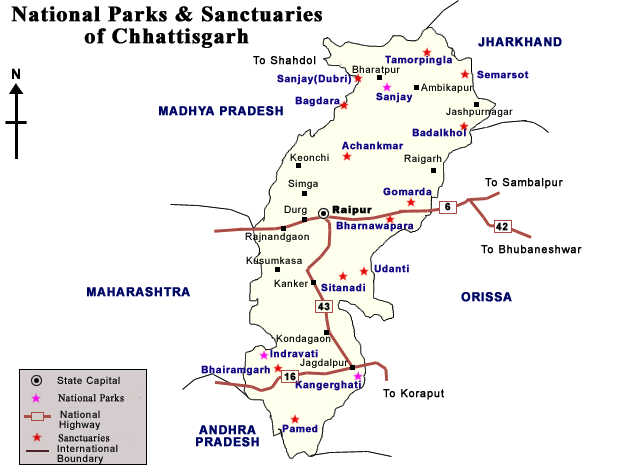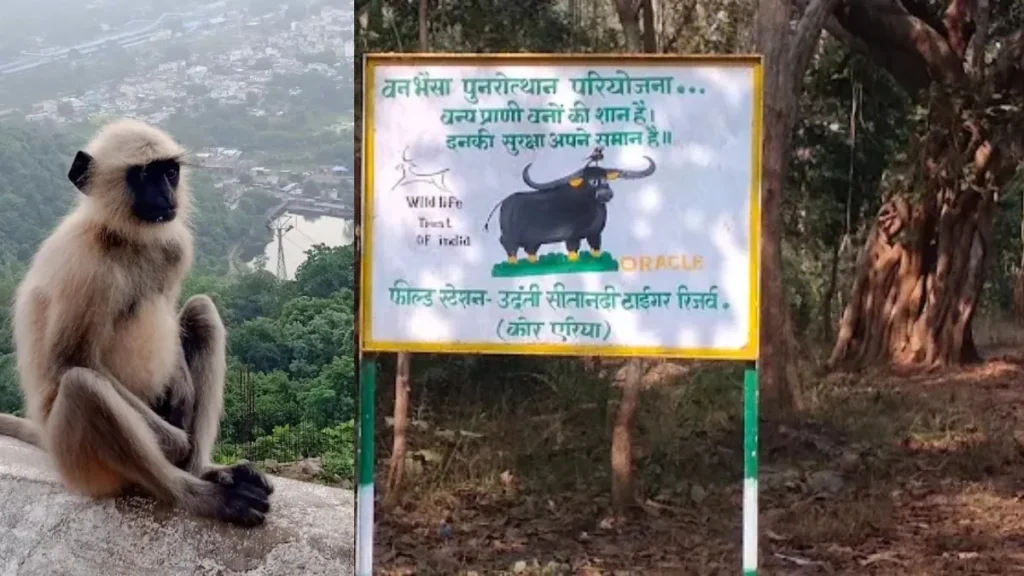
Udanti-Sitanadi Tiger Reserve
Constituent Sanctuaries : Udanti-Sitanadi Tiger Reserve (USTR) comprises two primary wildlife sanctuaries: Udanti Wildlife Sanctuary, which spans 237 square kilometers and Sitanadi Wildlife Sanctuary, which covers 556 square kilometers.
These sanctuaries were combined to form the tiger reserve under Project Tiger.
It is located in the Gariaband and Dhamtari Districts of Chhattisgarh.

The drainage system of the reserve consists of Mahanadi as the main river, along with Udanti and Sitanadi rivers as tributaries.
Flagship Fauna : The reserve is home to a variety of flagship species including the endangered Bengal tiger, Asiatic Wild Buffalo, Indian Elephant, Indian leopard, Sloth bear, Indian wolf and mouse deer.
Along with the Indravati Tiger Reserve, Udanti Sitanadi Tiger Reserve is an important refuge for the last few herds of the endangered Asiatic Wild Buffalo (Bubalus arnee) also known as Wild Water Buffalo.
Asiatic Wild Buffalo is the state animal of Chattisgarh.

Their horns spread up to 2 m, exceeding in size the horns of any other living wild bovid.
Wild Buffalo Conservation : Experts say that the pure breed of wild buffalo in India is now left only in Assam and Chhattisgarh.

Udanti-Sitanadi Tiger Reserve (USTR) remains a crucial area for the recovery of wild buffalo in central India. As part of species recovery efforts, captive-born wild buffaloes were radio-collared and released into the wild. This aids in tracking their movement and ensuring adaptation to the reserve.
-
Elephant Population in Udanti-Sitanadi Tiger Reserve : Initially home to only two elephant herds, the population has increased to approximately 40 individuals. This herd, known as Sikaser Dal, now roams freely across five of the sanctuary’s eight ranges. These elephants play an ecological role by transforming dense forests into open grasslands, thereby enhancing grazing spaces for herbivores and maintaining habitat balance. Their movement and actions, including breaking through thick forest undergrowth, resulted in the creation of open spaces.
- Approximately 250 hectares of grassland have emerged naturally, providing ample grazing grounds for a variety of herbivorous animals beyond just the elephants.
- Additionally, as elephants move and defecate, their droppings spread seeds, aiding in forest regeneration. This seed dispersal from elephant faeces has been observed contributing to new plant growth in USTR.
Flora : Mixed Vegetation : Dry deciduous forests, tropical and sub-tropical forests along waterways.
The predominant vegetation consists of Sal (Shorea robusta). Other major flora includes teak, bamboo, bel, semal, haldu, arjun, shisham, jamun and kuchla, contributing to a rich and diverse plant ecosystem.
Strategic Forest Corridor : USTR serves as a crucial wildlife corridor connecting regions such as Gadchiroli forests in Maharashtra, Indravati National Park in Chhattisgarh and Sunabeda Sanctuary in Odisha. This enhances genetic flow and long-range movement of species like bengal tigers and elephants across state-borders.
USTR hosts over 120 species of birds and numerous other fauna including wild boar, barking deer, jungle cat, four-horned antelope, striped hyenas, jungle fowl and several reptiles, underscoring its rich biodiversity.
Other significant fauna include sambar, nilgai, gaur and chital, making it a diverse ecological zone.
Camera Trap Evidence : The latest camera-trap surveys conducted in May 2025 indicate active usage of the reserve by tigers, leopards, elephants and sloth bears. The surveys also highlight a recovering population of prey species such as chital and nilgai.
Prey Base Recovery : The density of prey species has shown marked improvement. In 2018, it was estimated at 1 individual per square kilometer, which has now increased to 4–5 individuals per square kilometer, indicating a healthy ecological balance.
Census Status : While formal tiger census data is under compilation, indicators from field surveys and camera traps suggest a positive trend in tiger movement and habitation within USTR.

Anti-Poaching Measures : USTR has robust anti-poaching mechanisms involving coordination among forest staff, local villagers, police cyber cells, Directorate of Revenue Intelligence (DRI) and CRPF. This is especially vital in areas affected by Maoist activities.
Encroachment Removal : Over 750 hectares of forest land were cleared of illegal encroachments over the past three years. These efforts have helped restore wildlife habitats and reduce human-wildlife conflicts. Women-led Eviction Drives : In June 2025, a peaceful eviction operation led by women officers successfully removed encroachments from 60.7 hectares. This highlighted community cooperation and leadership in forest conservation.
Drone and AI Monitoring : A remote-sensing and drone-mapping initiative was launched in June 2024 using AI-based tools like Google Earth Engine. It aids in monitoring canopy loss, fire incidents, water stress and encroachment in the tiger corridor.
Technological Innovations : The drone mapping project, costing approximately ₹2.85 lakh, provides high-resolution images with 5 cm accuracy.
It is India’s first such state-level initiative for forest monitoring at this scale.
The drone-generated data supports tracking of plantation success, groundwater harvesting structures, fire lines and potential encroachment zones, enhancing data-driven decision-making in conservation.
Community Forest Rights (CFR) : Local tribal communities have been granted Community Forest Resource rights, empowering them to manage and protect forest resources in a sustainable and participatory manner.
Periodic shepherd community meetings known as ‘Charwaha Sammelans’, are organized to engage with local graziers. These initiatives aim to reduce forest fires, poaching and illegal logging through mutual trust and awareness.
Human-Wildlife Conflict Mitigation : The ‘Elephant Alert App’ is used to track elephant movements in real time, helping villagers avoid conflict and allowing authorities to take timely mitigation actions.

Habitat Enrichment : Over 50 ponds have been restored or constructed. Additionally, 150 hectares of bamboo and 40 hectares of fruit-bearing plantations have been created to provide food and habitat for elephants and other herbivores.
Frontline Staff Training : Under the Van Rakshak Project by Wildlife Trust of India (WTI), forest staff have been trained in wildlife crime prevention, evidence collection, and legal protocols, thereby enhancing enforcement capability.
Tourism and Infrastructure : Sustainable tourism initiatives are being developed, including boat rides, cottages and jeep safaris. Paragliding facilities near Sondhur reservoir are under consideration, though conservation remains the top priority.

